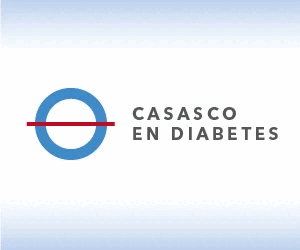MESA 1: NUEVOS MEDICAMENTOS EN DIABETES MELLITUS TIPO 1
DOI:
https://doi.org/10.47196/diab.v49i3.633Palabras clave:
nuevos medicamentos, diabetes mellitus tipo 1Resumen
¿Hacia dónde va la investigación? ¿Cuáles son los puntos débiles de los medicamentos actuales? ¿Qué características deben tener los nuevos medicamentos?
Citas
I. Chillarón JJ, Goday A, Pedro-Botet J. Metabolic syndrome, type 1 diabetes mellitus and insulin resistance. Med. Clin. (Barc.) 2008; 130 :466-71.
II. Chillarón JJ, Flores Le-Roux JA, Benaiges D, Botet JP. Type 1 diabetes, metabolic syndrome and cardiovascular risk. Metabolism Clinical and Experimental 2014; 63: 181-187.
III. Hamilton J, Cummings E, Zdravkovic V, et al. Metformin as an adjunct therapy in adolescents with type 1 diabetes and insulin resistance: a randomized controlled trial. Diabetes Care 2003; 26:138-143.
IV. Timar R, Timar B, Degeratu D, et al. Metabolic syndrome, adiponectin and proinflammatory status in patients with type1 diabetes mellitus. J. Int. Med. Res. 2014; 42:1131-1138.
V. Teupe B, Bergis K. Epidemiological evidence for “double diabetes”. Lancet 1991; 337:361-2.
VI. Laing SP, Swerdlow AJ, Slater SD, et al. The British Diabetic Association Cohort Study II: cause-specific mortality in patients with insulin-treated diabetes mellitus. Diabet Med 1999; 16:46671.
VII. Bailey CJ. Metformin: effects on micro and macrovascular complications in type 2 diabetes. Cardiovasc. Drugs Ther. 2008; 22: 215-224.
VIII. Vella S, Buetow L, Royle P, et al. The use of metformin in type 1 diabetes: a systematic review of efficacy. Diabetologia 2010; 53:809-820.
IX. Cong Liu, Dan Wu, Xuan Zheng, Ping Li, Ling Li. Efficacy and safety of metformin for patients with type 1 diabetes mellitus: a meta-analysis. Diabetes Technology & Therapeutics 2015;17:142-
X. Sanblad S, Kroon M, Aman J. Metformin as additional therapy in adolescents with poorly controlled type 1 diabetes: randomised placebo-controlled trial with aspects on insulin sensitivity. Eur. J. Endocrinol. 2003; 149:323-329.
XI. Pang TT, Narendran P. Addressing insulin resistance in type 1 diabetes. Diabet. Med. 2008; 25:1015-1024.
XII. Cervera A, Wajcberg E, Sriwijitkamol A, Fernandez M, Zuo P, Triplitt C, Musi N, DeFronzo RA & Cersosimo E. Mechanism of action of exenatide to reduce postprandial hyperglycemia in type 2 diabetes. American Journal of Physiology. Endocrinology and Metabolism 2008, 294 E846-E852.
XIII. Holst JJ. The physiology of glucagon-like peptide 1. Physiol. Rev. 2007; 87:1409-1439.
XIV. Madsbad S, Krarup T, Deacon CF, Holst JJ. Glucagon-like peptide receptor agonists and dipeptidyl peptidase-4 nhibitors in the treatment of diabetes: a review of clinical trials. Curr Opin Clin. Nutr. Metab. Care. 2008 Jul; 11(4):491-9.
XV. Zander M, Madsbad S, Madsen JL, Holst JJ. Effect of 6-week course of glucagonlike peptide 1 on glycaemic control, insulin sensitivity, and beta-cell function in type 2 diabetes: a parallel. Lancet. 2002 Mar 9; 359(9309):824-30.
XVI. Vilsbøll T, Toft-Nielsen MB, Krarup T, Madsbad S, Dinesen B, Holst JJ. Evaluation of b-cell secretory capacity using glucagonlike peptide 1. Diabetes Care 2000; 23:807-812
XVII. Kielgast U, Holst JJ, Madsbad S. Treatment of type 1 diabetic patients with glucagon-like peptide-1 (GLP-1) and GLP-1R agonists. Curr. Diabetes Rev. 2009; 5:266-275.
XVIII. Behme MT, Dupré J, McDonald TJ. Glucagon-like peptide 1 improved glycemic control in type 1 diabetes. BMC Endocr. Disord. 2003; 3:3.
XIX. Creutzfeldt WO, Kleine N, Willms B, Orskov C, Holst JJ, Nauck MA. Glucagonostatic actions and reduction of fasting hyperglycemia by exogenous glucagonlike peptide I(7-36) amide in type I diabetic patients. Diabetes Care 1996; 19:580-586.
XX. Raman VS, Mason KJ, Rodriguez LM, et al. The role of adjunctive exenatide therapy in pediatric type 1 diabetes. Diabetes Care 2010; 33:1294-1296.
XXI. Flint A, Raben A, Astrup A, Holst JJ. Glucagon-like peptide 1 promotes satietyand suppresses energy intake in humans. J. Clin. Invest. 1998; 101:515–520.
XXII. Gutzwiller JP, Göke B, Drewe J, et al. Glucagon-like peptide-1: a potent regulator of food intake in humans. Gut 1999; 44:81-86.
XXIII. Dupré J, Behme MT, McDonald TJ. Exendin-4 normalized postcibal glycemic excursions in type 1 diabetes. J. Clin. Endocrinol. Metab. 2004; 89:3469-3473.
XXIV. Kielgast U, Krarup T, Holst JJ, Madsbad S. Four weeks of treatment with liraglutide reduces insulin dose without loss of glycemic control in type 1 diabetic patients with and without residual β-cell function. Diabetes care, 2011, 34 (7), 1463-1468.
XXV. Varanasi A, Bellini N, Rawal D, Vora M, Makdissi A, Dhindsa S, Dandona P. Liraglutide as additional treatment for type 1 diabetes. European Journal of Endocrinology. 2011, 165(1), 77-84.
XXVI. Molnar GD, Rosevear JW, Ackerman E, Gatewood LC, Taylor WF. Mean amplitude of glycemic excursions, a measure of diabetic instability. Diabetes, 19(9), 644-655, 1970.
XXVII. Raman VS, Mason KJ, Rodriguez ML, Hassan K, Yu X, Bomgaars L, Heptulla RA. The role of adjunctive exenatide therapy in pediatric type 1 diabetes. Diabetes Care 33:1294-1296, 2010.
XXVIII. Novo Nordisk completes second and final phase 3º trial with liraglutide as adjunct therapy to insulin for people with type 1 diabetes (NN9211). In: http://globenewswire.com/news-release/2015/08/24/762981/0/en/Novo-Nordisk-completes-secondand-final-phase-3a-trial-with-liraglutide-as-adjunct-therapy-toinsulin-for-people-with-type-1-diabetes-NN9211.html. Acceso: septiembre 2015.
XXIX. Na-Hyung K, Taeyang Y, Dae HL. The nonglycemic actions of DPP-
Bio Med Research International. 2014. 1-2.
XXX. Bilal O, Bo A. Pleiotropic mechanism for the glucose lowerig action Of DPP-4 Inhibitors. Diabetes. 2014. 63,1-2.
XXXI. Zazueta A. Polipéptido insulinotrópico dependiente de glucosa y péptido semejante al glucagón tipo 1: acciones fisiológicas e implicaciones en la diabetes tipo 2 y la obesidad. Revista de Endocrinología y Nutrición. 2007. 15, 3: 156-164.
XXXII. Bosi E. Time for testing incretin therapies in early type 1 diabetes? Journal Clinical Endocrinol. Metab. 2010, 95(6):2607-2609.
XXXIII. Drucker DJ. The biology of incretin hormones. 2006. Cell Metab. 3:153-165.
XXXIV. Zhao Y, Yang L,Wang X, et al. The new insights from DPP-4 inhibitors: their potential immune modulatory function in autoimmune diabetes. Diabetes/metabolism research and reviews.2014:30:646-53.
XXXV. Juang J, Kuo CH, Liu Y, et al. Effects of dipeptidyl peptidase-4 inhibition with MK-0431 on syngeneic mouse islet transplantation. International Journal of Endocrinology 2014. 1-6.
XXXVI. Shah P, Amin Ardestani A, Dharmadhikari G, et,al. The DPP-4 inhibitor linagliptin restores. Cell function and survival in human isolated islets through GLP-1 stabilization J. Clin. Endocrinol. Metab., 2013, 98(7):1163-1172.
XXXVII. Lee M. Treatment of autoimmune diabetes by inhibiting the initial event. Immune Network 2013. 13, 5: 194-198.
XXXVIII. Zhao Y, Yang L, Xiang Y, et al. Dipeptidyl peptidase 4 inhibitor sitagliptin maintains cell function in patients with recent-onset latent autoimmune diabetes in adults: one year prospective study. J. Clin. Endocrinol. Metab. 2014, 99(5):876-880.
XXXIX. Johansen O, Boehm B, Gril V, et al. C-Peptide levels in latent autoimmune diabetes in adults treated with linagliptin vs glimepiride. Exploratory results from a 2-year double-dlind, randomized, controlled study. Diabetes Care 2014. 37:11-12.
XL. Kuhtreiber W, Washer S, Zhao H. Low levels of C-peptide have clinical significance for established type 1 diabetes. Diabetic Medicine 2015, 1346-1353.
XLI. DeGeeter M, Williamson B. Alternative agents in type 1 diabetes in addition to insulin therapy: metformin, alpha-glucosidase inhibitors, pioglitazone, GLP-1 agonists, DPP-IV inhibitors, and SGLT-2 inhibitors. Journal of Pharmacy Practice 2014.1-16.
XLII. Kutoh E.Sitagliptin is effective and safe as add-on to insulin in patients with absolute insulin deficiency: a case series. Journal of Medical Case Reports 2011, 5:11.
XLIII. Garg SK, Moser EG, Bode BW, et al. Effect of sitagliptin on postprandial glucagon and GLP-1 levels in patients with type 1 diabetes: investigator-initiated, double-blind, randomized, placebo controlled trial. Endocrinología Práctica. 2013 19(1):19-28.
XLIV. Ellis S, Moser E, Snell-Bergeon J. Effect of sitagliptin on glucose control in adult patients with type 1 diabetes: a pilot, doubleblind, randomized, crossover trial. Diabetic Medicine. 2011. 1176 -1181.
XLV. Giampietro O, Giampietro C, Bartola LD, et al. Sitagliptin as add on therapy in insulin deficiency: biomarkers of therapeutic efficacy and respond differently in type 1 and type 2 diabetes. Drug Design, Development and Therapy 2013; 7:99-104.
XLVI. Farngren J, Persson M, Schwizer A, et al. Vidagliptin reduces glucagon during hyperglycemia and sustains glucagon counterregulation during hypoglycemia in type 1 diabetes. J. Clin. Endocrinol. Metab. 2012; 97(10)3799-3806.
XLVII. Henry RR, Rosenstock J, Edelman S, et al. Exploring the potential of the SGLT2 inhibitor dapagliflozin in type 1 diabetes: a randomized, double-blind, placebo controlled pilot study. Diabetes Care 2015; 38:412-419.
XLVIII. Pieber TR, Famulla S, Eilbracht J, et al. Empagliflozin as adjunct to insulin in patients with type 1 diabetes: a 4-week, randomized, placebo-controlled trial (EASE-1). Diebetes, Obesity and Metabolism 2015, Oct.; 17(10):928-35.
XLIX. Perkins BA, Cherney DZI, Partridge H, et al. Sodium-glucose cotransporter 2 inhibition and glycemic control in type 1 diabetes: results of an 8-week open-label proof-of-concept trial. Diabetes Care 2014; 37:1480-1483.
L. Cherney DZI, Perkins BA. Sodium-glucose cotransporter 2 inhibition in type 1 diabetes: simultaneus glucose lowering and renal protection?. Can. J. Diabetes 38, 2014, 356-363.
LI. Cherney DZI, Perkins BA, Soleymanlou N, et al. Renal hemodynamic effect of sodium-glucose cotransporter 2 inhibition in patients with type 1 diabetes mellitus. Circulation. 2014 Feb 4; 129(5):587-97.
LII. Cherney DZI, Perkins BA, Soleymanlou N, et al. The effect of empagliflozin on arterial stiffness and heart rate variability in subjects with uncomplicated type 1 diabetes mellitus. Cardiovascular Diabetology 2014,13:28.
LIII. Rosenstock J, Ferrannini E. Euglycemic diabetic ketoacidosis: a predictable, detectable, and preventable safety concern with SGLT2 inhibitors. Diabetes Care 2015; 38:1638-1642.
LIV. Hattersley AT, Thorens B. Type 2 diabetes, SGLT2 inhibitors, and glucose secretion. N. Engl. J. Med. 373; 10. September 3, 2015.
LV. Taylor SI, Blau JE, Rother KI. SGLT2 inhibitors may predispose to ketoacidosis. J. Clin. Endocrinol. Metab. 100: 2849-2852, 2015.
LVI. Bonner C, Kerr-Conte J, Gmyr V, et al. Inhibition of the glucose transporter SGLT2 with dapagliflozin in pancreatic alpha cells triggers glucagon secretion. Nat Med. 2015 May; 21(5):512-7.
LVII. Atkinson MA, Maclaren NK. The pathogenesis of insulin-dependent diabetes mellitus. N. Engl. J. Med. 1994; 331: 1428-1436.
LVIII. The Diabetes control and Complications Trial Research Group: the effect of intensive treatment of diabetes on the development and progression of long-term complications in insulin-dependent diabetes mellitus. N. Engl. J. Med. 1993; 329: 997-986.
LIX. Weyer C, Gottlieb A, Kim DD, Lutz K, et al. Pramlintide reduces postprandial glucose excursions when added to regular insulin or insulin lispro in subjects with type 1 diabetes. Diabetes Care 2003; 26 N° 11: 3074-3079.
LX. Heptula RA, Rodriguez LM, Bomgaars L, Haymond MW. The role of amylin and glucagon in the dampening of glycemic excursions in children with type 1 diabetes. Diabetes 2005; 54: 11001107.
LXI. Vella A, Lee JS, Camilleri M, Szarka LA, et al. Effects of pramlintide, and amylin analogue, on gastric emptyng in type 1 and 2 diabetes mellitus. Neurogastroenterol. Mot. 2002; 14: 123-131.
LXII. Alfonso JE, Sierra Ariza ID. Nuevas terapias en diabetes: más allá de la insulina inyectable y de los antidiabéticos orales. Rev. Assoc. Med. Bras. 2008; 54 (5): 447-454.
LXIII. Bailey RJ, Walker CS, Ferner AH, et al. Pharmacological characterization of rat amylin receptors: implications for the identication of amylin receptor subtypes. British Journal of Pharmacology 2012; 166: 151-167.
LXIV. Riddle MC, Drucker D. Emerging therapies mimicking the effects of amylin and glucagon-like peptide 1. Diabetes Care 2006; 29: 435-449.
LXV. Schmitz O, Brock B, Rungby J. Amylin agonist: a novel approach in the treatment of diabetes. Diabetes 2004; 53 (3): S233- S238.
LXVI. Fixed ratio dosing of pramlintide with regular insulin before a standard meal in patients with type 1 diabetes. Research letter. Diabetes, Obesity and Metabolism 2015; 17: 904-907.
LXVII. Jansson JO, Palsdottir V- Brain. Il-6. Where amylin and GLP-1 antiobesity signaling congregate. Diabetes 2015; 64: 1498-1499.
LXVIII. Research letter: safety of pramlintide added to mealtime insulin in patients with type 1 or type 2 diabetes: a large observational study. Diabetes, Obesity and Metabolism 2010; 12: 548-551.
LXIX. Akkati S, Sam KG, Tungha G. Emergence of promising therapies in diabetes mellitus. J. Clin. Pharmacol. 2011; 51: 796-804.
LXX. Edelman S, Garg S, Frias J, et al. A double-blind, placebo-controlled trial assessing pramlintide treatment in the setting of intensive insulin therapy in type 1 diabetes. Diabetes Care 2006; 29: 2189-2195.
LXXI. Whitehouse F, Kruger AF, Fineman M, et al. A randomized study and open-label extension evaluating the long- term efficacy of pramlintide as an adjunt to insulin therapy in type 1 Diabetes. Diabetes Care 2002; 25: 724-730.
LXXII. Thompson RG, Peterson J, Gottlieb A, Mullane J. Effects of pramlintide, an analog of human amylin, on plasma glucose profiles in patients with IDDM. Diabetes 1997;46: 632-637.
LXXIII. Weinzimer SA, Sherr JL, Cenginz E, et al. Effect of pramlintide on prandial glycemic excursions during closed-loop control in adolescents and young adults with type 1 diabetes. Diabetes Care 2012; 35: 1994-1999.
LXXIV. Marrero DG, Crean J, Zhang B, Kellmeyer T, et al. Effect of adjunctive pramlintide treatment on treatment satisfaction in patients with type 1 diabetes. Diabetes Care 2007; 30: 210-216.
LXXV. Lee N, Norris SL, Thakurta S. Efficacy and harms of the hypoglycemic agent pramlintide in diabetes mellitus. Annals of Family Medicine 2010; 8 N° 6: 542-549.
LXXVI. DeGeeter M, Williamson B. Alternative agents in type 1 diabetes in addition to insulin therapy: metformin, alpha-glucosidase inhibitors, pioglitazone, GLP-1 agonists, DPP-IV inhibitors, and SGLT-2 inhibitors. Journal of Pharmacy Practise 2014; 1-16.
LXXVII. Dash S, Crisp S; Hartnell S, et al. Successful use of acarbose to manage post-prandial glycaemia in two patients with type 1 diabetes on continuous subcutaneous insulin infusion. Diabetes Research and Clinical Practice 2012; 95: e49-e51.
LXXVIII. Rabasa-Lhoret R, Burelle Y, Ducros F, et al. Use of an alpha-glucosidase inhibitor to maintain glucose homoeostasis during postprandial exercise in intensively treated type 1 diabetic subjects. Diabetic Medicine 2001; 18: 739-744.
Descargas
Publicado
Cómo citar
Número
Sección
Licencia
Derechos de autor 2015 a nombre de los autores. Derechos de reproducción: Sociedad Argentina de Diabetes

Esta obra está bajo una licencia internacional Creative Commons Atribución-NoComercial-SinDerivadas 4.0.
Dirección Nacional de Derecho de Autor, Exp. N° 5.333.129. Instituto Nacional de la Propiedad Industrial, Marca «Revista de la Sociedad Argentina de Diabetes - Asociación Civil» N° de concesión 2.605.405 y N° de disposición 1.404/13.
La Revista de la SAD está licenciada bajo Licencia Creative Commons Atribución – No Comercial – Sin Obra Derivada 4.0 Internacional.
Por otra parte, la Revista SAD permite que los autores mantengan los derechos de autor sin restricciones.





























